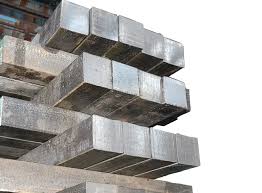Steel billets are the raw building blocks of many everyday products from construction beams to automotive parts and machinery. Even though we don’t usually see them in finished goods, billets are a key part of the steel supply chain. That’s why any major price change in steel billets affects not just manufacturers but also prices of finished steel products across industries.
If you’ve been tracking steel prices this year, you might have noticed a surprising trend: steel billet prices have dropped. According to PriceWatch, during Q2 2025, steel billet prices fell by $443 per metric ton, a 3.49% decrease, based on FOB Shanghai (Free on Board) prices. This decline marks a shift in a market that’s often driven by demand from fast-developing economies and major infrastructure projects.
In this article, we’ll explore in simple and natural language why this drop happened, what factors influenced it, and what this means for buyers, sellers, and industries dependent on steel billets.
What Are Steel Billets and Why Do Prices Matter?
Let’s start with the basics. Steel billets are semi-finished steel products, usually square or rectangular in shape. They are created by melting raw materials and casting them into these basic forms. Later, they are rolled or forged into other steel products like rods, bars, or sheets.
In short, steel billets are the starting point of many steel goods. So, when billet prices rise or fall, it sets the tone for the entire steel industry.
What Did PriceWatch Report in Q2 2025?
According to the PriceWatch data for the second quarter of 2025:
-
Steel billet prices fell by $443 per metric ton.
-
That’s about a 3.49% decrease compared to the previous quarter.
-
The pricing is based on FOB Shanghai, which means the price quoted is for goods loaded onto ships in Shanghai before being exported.
This drop is not a small dip it’s significant enough to impact global trade, project budgets, and raw material purchasing decisions.
For latest updates, price queries, demand forecasts, and supplier information related to Steel Billet prices, submit your request here: https://www.price-watch.ai/contact/
What Caused This Price Drop?
Steel is a global commodity, and its prices depend on various factors happening around the world. In Q2 2025, several key developments came together to push billet prices downward.
1. Geopolitical Instability
One of the biggest influences on the market right now is the ongoing geopolitical instability, especially in Eastern Europe and parts of the Middle East. These regions are important for steel trade and infrastructure development.
Due to conflicts and unrest, many infrastructure projects have either slowed down or come to a halt. When construction stops, so does the need for steel. This sudden drop in demand has put pressure on steel billet prices.
2. Shifting Tariff Policies and Trade Barriers
Another major factor is the changing global trade environment. Countries are becoming more protectionist—meaning they’re putting their own industries first by raising tariffs on imported goods.
-
The United States has imposed higher tariffs on some steel products.
-
In response, China and the European Union (EU) have taken their own retaliatory steps.
This tit-for-tat on tariffs has disrupted the usual flow of global steel trade. Since exporters can’t sell to their regular markets as easily as before, they’re forced to redirect their shipments to other, less restricted countries. This creates oversupply in some regions, which leads to lower prices due to increased competition.
3. Buyers Holding Off on Purchases
Trade uncertainty has also made buyers more cautious. With talks of new tariffs and unclear trade deals, many buyers are choosing to delay their purchases. They’re waiting to see how the market plays out instead of making big orders.
This waiting game has lowered demand further, giving sellers less room to raise or even maintain prices. In the end, many are accepting lower prices just to keep moving inventory.
What Does This Mean for Different Stakeholders?
Let’s break it down from a few different points of view.
For Exporters and Manufacturers:
-
The price drop makes it harder for steel manufacturers to maintain profit margins.
-
Exporters now face tougher competition as they all try to sell into limited open markets.
-
Some companies may have to cut production or offer heavy discounts to keep business flowing.
For Buyers and Importers:
-
This is actually good news for buyers looking to stock up on billets or raw materials.
-
Lower prices mean reduced costs for manufacturers of finished steel products.
-
But the uncertainty may still cause them to buy carefully and not go all-in just yet.
For Governments and Policy Makers:
-
Governments may step in to protect domestic industries if low import prices threaten local producers.
-
On the flip side, some countries may take advantage of the cheaper steel inputs to boost their own manufacturing.
How Long Could This Trend Last?
It’s hard to say with certainty, but some clues suggest that the downward trend could continue in the short term, unless:
-
Geopolitical tensions ease, allowing halted construction and infrastructure projects to restart.
-
Trade policies stabilize, making the global steel market more predictable.
-
Or if demand from major economies like India or Southeast Asia picks up, it could help absorb excess supply.
For now, the market appears cautious. Even though prices are down, uncertainty is high. That’s causing both sellers and buyers to think twice before making big moves.
What Should Industry Players Do?
Given the current market situation, here are a few simple strategies businesses can consider:
-
Monitor Markets Closely: This is a sensitive time. Even small news like tariff changes or ceasefires in conflict zones could move prices.
-
Secure Short-Term Contracts: Buyers might benefit from locking in current lower prices while avoiding long-term commitments.
-
Diversify Suppliers or Buyers: To avoid relying too heavily on any one country or trade partner, spreading business across regions could reduce risk.
-
Stay Agile: Flexibility in sourcing and production planning can help businesses adapt quickly if prices suddenly bounce back.
Final Thoughts – A Shift, Not a Crisis
The 3.49% drop in steel billet prices in Q2 2025 is more of a market adjustment than a major crash. It’s a reflection of the world’s changing economic and political climate. Global events, especially conflicts and trade policies, are shaping how steel flows from one country to another and what it costs.
For now, this softening of prices is offering some breathing room to buyers, while challenging producers to stay competitive. Like with many global materials, the steel billet market reminds us that prices don’t just depend on supply and demand they’re also shaped by human decisions, political events, and economic strategies.
As we move into Q3 and Q4 of 2025, the steel industry will be watching closely to see whether this downward trend continues or if the market finds its footing again.


